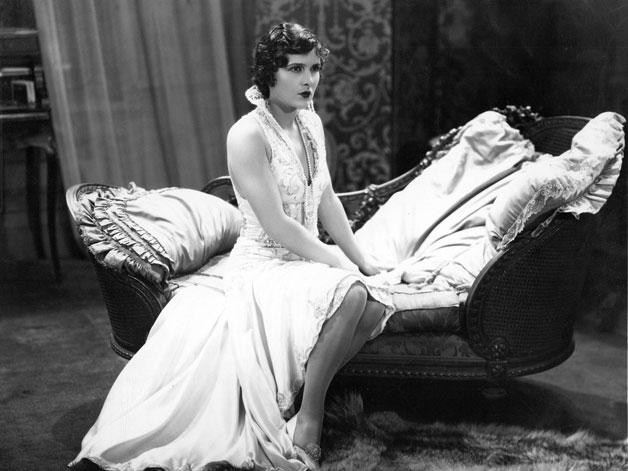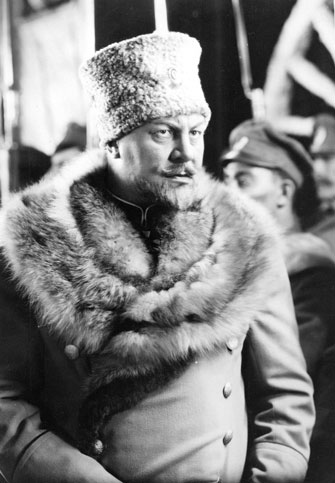THE LAST COMMAND (1928)
 |
| Reviewed by Mordaunt Hall The New York Times January 23, 1928 From the standpoint of its narrative, Emil Jannings's latest picture, "The Last Command," now at the Rialto Theatre, is one of the most, satisfactory of shadow stories. It is logical throughout. It was inspired by the experiences of a Russian General, who fled to this country after the revolution in his own land. This production has its forced moments, its sluggish incidents, but the chronicle is equipped with a double strain of suspense. It strikes one as a good short story turned to excellent account in film form. It is a far more plausible account than that of "The Way of All Flesh," but in the older picture the detail was more carefully filmed than that of "The Last Command." This current offering has a clever finish, an ending that is particularly skillfully devised, and one that is most effective. And if there are moments when Mr. Jannings holds the same expression and pose too long, you are rewarded for the most part with a brilliant performance in which there is a wealth of imagination. In the closing scenes Mr. Jannings gives a highly gifted and gripping portrayal of the last moments of the bent and bowed czarist generalissimo working as an extra in a motion picture studio. You see General Dolgorucki meet his death in the same uniform he wore with pomp and confidence of his high office before the red flag flew from Moscow's Kremlin, and the fiddle, a piano and a cello are rendering the old Russian National anthem. |
 Mr. Jannings does not wear a cap in this scene, as he realized that it would conceal to a certain extent his various expressions. He is magnificent as he straightens up at the sound of his militant hymn and then drops to the studio "snow." "He was a great actor, that old guy," observes the casting director. "And a great man, which is more," I adds the picture director, who incidentally in Russia had felt the General's riding crop on his cheek. The motion picture end of this feature is wonderfully good, even to the selection of the players. There are the "yes men," the light experts, the electric wires like eels around the studio floor. The instructions are done to a T, without anything being too extravagant. The story opens up with the choosing of a General for the battle scene, and Dolgorucki's photograph is brought out. It results in his selection and soon the casting director's assistant is on the wire calling Dolgorucki on the telephone at his shabby abode. He is told to report at 6:30 the next morning. As the broken Russian military commander, Jannings gives a hint of the man's sufferings. He wears a beard. His face is that of an aristocrat, but every half second he shakes his head, like a man suffering from shell shock. They gibe him about this in the studio and scoff at him when he tells them, the other extras, that the Czar gave him his military cross. Jannings is perceived gazing at his make-up box, the cover of which is a mirror. He looks, every so often shaking his head. Then comes a fade-out and soon one sees the General as he had been before the Kerensky or Soviet days. He is a man of courage, one who may use his riding crop occasionally, but who is not cruel. He loves his fatherland and even sneers at the Czar for taking a division of troops, from the battle front to satisfy the Little Father's vanity. |
 |
| More might have been accomplished with these Russian scenes to give a better idea of the General. His style appears to be cramped at times, for while one is told that he is a cousin of the Czar and commander of the Russian armies, be does not appear to be doing much more than the work of a captain.
There is pictured the flaring up of the rabble, and Jannings is shown with swollen lips, blood-smeared, standing against a wall of a railway station. In some of these flashes Mr. Jannings—who, as the General, admittedly has suffered frightful punishment—could nevertheless have shown in his eyes some fire when the men and women goad him and spit water in his face. His strength may have been ebbing, but he now and again lifts some coal to the locomotive's fire, and subsequently he musters up enough strength to bang the locomotive driver over the head with a shovel, and then to leap from the locomotive to the snow. But it is Mr. Jannings's splendid work that causes one to want just a bit more. He lives the character and the most trifling shortcoming makes one wonder at it. After the chapters in Russia, wherein there is qute a good portrait of the last Czar, the story goes back to the studio. Evelyn Brent is pleasing as a girl who helps the General. William Powell gives a sterling portrait of a motion picture director and also as one of the ringleaders of the infuriated mob. |